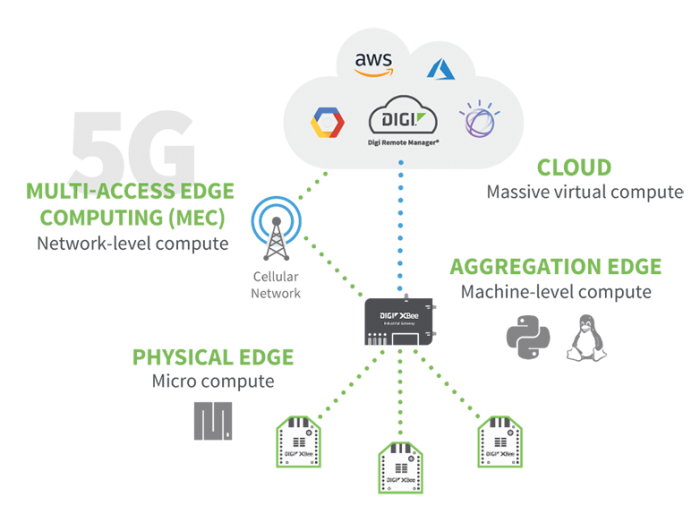The advent of 5G has cast a considerable amount of doubt and fear across the IoT landscape, as many developers, systems integrators, network operators and business decision makers determine how to move forward with their application development and IoT deployment plans.
At Digi, we help customers build products and deploy intelligent networks. Therefore, our point of view is pragmatic. What do our customers need to know now, and when does 5G become actionable? In this interview with Harald Remmert, Digi Director of Engineering and an expert in network technology, we examine whats real.
Note: Since the publication of this blog post in 2019, much has changed! Please see the following updated resources: Digi's 5G Technology Page, Digi's 5G Resource Library, and our blog post on Digi 5G Products.

Timing of 5G
Interviewer: The scariest thing for me about 5G is when I hear about nodes being put up on 50 m^2 grids. That is a lot of nodes. How is this going to happen and how long will it take?
Harald: That's correct. Mobile operators have been very busy over the last years, densifying their 4G LTE networks to handle the exponential growth of devices and mobile data traffic. Small cells, which are low-cost miniature base stations, have become a key tool to service more devices per area. In urban areas, you may find small cells installed at every intersection, on light poles, in manholes, in buildings, and pretty much everywhere devices and people need coverage. Small cells deployed today are upgradable to 5G through a software update. To give you an idea of the scale of smart cell deployments, TrendForce estimated that global smart cell deployments will reach 4.3 million in 2019, a 50%+ growth year-over-year from the 2.8 million in 2018.
Interviewer: How long will this take?
Harald: There is no target date. It's a constant improvement process and driven by location and the number of devices by location.
5G Bandwidth, Throughput and IoT
Interviewer: Most business forums talk as if 5G is synonymous with higher bandwidth and throughput. But most of the IoT is about the low Cats. What does 5G mean for people thinking about the low Cats?
Harald: Good question. The initial focus of 3GPP in Release 15 was on the enhanced Mobile Broadband (eMBB) use case, or in other words the high Cats. But 5G has much more to offer.
For IoT applications, 3GPP release 13 was instrumental and laid the foundation by defining low-power, lower-speed categories like 4G LTE-M or 4G NB-IoT. 5G builds on this foundation and enhances the network to support millions of devices per km^2.
5G will also bring ultra-reliable, low latency (uRLLC) to IoT devices. Low latency of sub-10ms compared to the typical 50-100ms today means that devices can interact with each other or with their own infrastructure much faster, enabling many new real-time use-cases.
Interviewer: Perhaps the most important promise of 5G to the industrial space is low latency. How will this happen, and will it really mean closing the loop on industrial solutions?
Harald: 5G will achieve low latency in three ways:
- Shorter timeslots at the physical radio layer
- Higher frequencies such as mmWave
- Moving intelligence from centralized network cores to de-centralized network cores closer to the edge
Moving intelligence closer to the edge is also something that IoT customers need to think about as they are evaluating how their IoT applications can benefit from 5G. 5G low-latency will not make a difference, if data is sent across the country to a data center and back, with 200ms+ round-trip latencies. Data centers will move closer to the edge, sometimes as close as to a cell site.
5G and Private Networks
Interviewer: Another important promise of 5G is sometimes referenced as MulteFire private networks. How will this work and how do you see this changing an IoT developers relationships with the carriers?
Harald: Private LTE networks based on shared spectrum such as CBRS, or unlicensed spectrum such as MulteFire, will enable customers to become independent of mobile network operators. However, mobile network operators also see this trend and may offer solutions based on private LTE to their customers.
There are numerous benefits of private LTE networks:
- Customers no longer need to worry about data plans and overages.
- Improved security: sensitive data does not have to traverse over a public network.
- Dedicated network that does not have to be shared with other tenants
Interviewer: How will this work?
Harald: Similar to Wi-Fi Access Points today, customers will deploy an on-premise small cell that cellular devices can then securely connect to.
5G and Enterprise Networks
Interviewer: What will be the key to these enterprise networks nodes, routers, modems, network management, other?
Harald: I think the key to these evolving enterprise networks is a technology partner such as Digi who understands these trends and offers solutions that are flexible and can evolve along with these network changes.
Key offerings to look for in a technology partner:
- Customer-upgradable hardware: For example, instead of replacing the complete router, customers just swap a 2G or 3G radio module with 4G LTE or in the future 5G module. 5G will not obsolete 4G devices, vendors need to support customers in planning manageable, low-cost upgrades.
- Remote Device Management: Gone are the days where a device gets deployed without any updates through its life. With technologies and networks changing, as well as security vulnerabilities and improvements, customers need to have a strategy to keep their distributed devices up-to-date.
Interviewer: Why is there some much discussion about AT&T and their definition of 5G? Why are they getting negative press on this?
Harald: AT&T decided to market their 4G LTE network as 5G Evolution (5Ge), which has led many customers into believing that their phones will be able to connect to a 5G infrastructure after a software update. The reality is that AT&Ts 5Ge has nothing to do with next-generation 5G, and the industry is churning about that. To add to the challenges, AT&Ts version of standards-based 5G is now called 5G+.
It is part of AT&Ts strategy to be positioned as a leader in emerging technology. For example, in 2011 AT&T and T-Mobile started to market HSPA+ as 4G, and then later LTE as 4G LTE.
Interviewer: So why is AT&T doing this?
Harald: The intention is to show customers that parts of their network have LTE Advanced Pro deployed, which is faster than "regular LTE," approaching early 5G speeds of 100 Mbps or more. A perhaps better move would have been for AT&T to call this 4G Evolution (or 4Ge), which probably everybody in the industry would have accepted.
Interviewer: Will the proliferation of 5G nodes create new opportunities for fog computing? How do you see this new layer of compute changing how enterprises deploy IoT applications?
Harald: Absolutely! Today, the IoT stack has three layers of compute — cloud, aggregation edge (gateways) and the physical edge (connected sensors and devices). With 5G, there is another layer at the cellular network edge called Multi-Access Edge Computing (MEC), with a low-latency connection to the Aggregation Edge.

MEC provides massive compute power and enables applications to process data close to where it is generated and consumed, resulting in ultra-low latency often required by mission- and business-critical applications. By processing data locally, MEC applications can also significantly reduce data transfer costs and scale as needed without having to replace the Aggregation Edge device.
Thank you, Harald, for your insights.
To summarize our stance at Digi, wed like to leave our readers with the following messages:
- 5G is important, and a game-changer. There is an enormous amount of infrastructure that must be installed on the way to completion of 5G networks. We have our fingers on the pulse, and will keep you informed.
- Edge compute is vitally important to IoT, and will support the scalability and success of future applications.
- IoT stack integration is facilitated by a device manager. In our customers case, this is Digi Remote Manager, a sophisticated toolset for securely managing distributed networks and proactively addressing outages and vulnerabilities.
- Retrofit is a key to IoT business success. As a solutions provider, we believe in supporting our customers in planning smart, cost-effective deployments that utilize existing capital investments. And we provide all the consulting and support they need to do that.